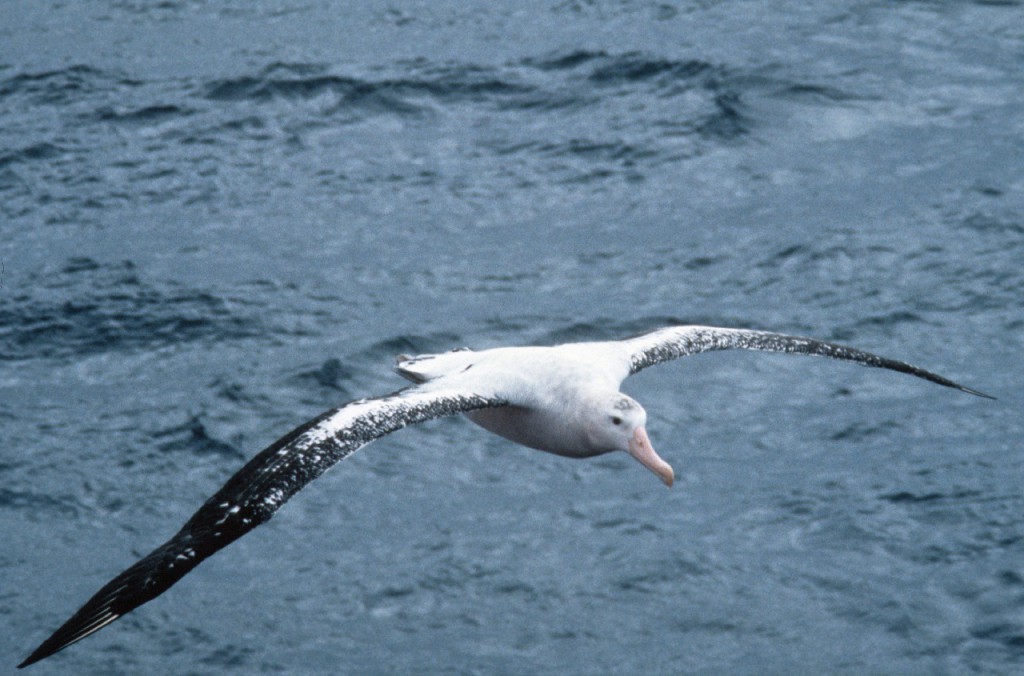Albatross camera reveals fascinating feeding interaction with killer whale
Scientists from British Antarctic Survey, National Institute of Polar Research (NIPR), Tokyo, and Hokkaido University, Japan, have recorded the first observations of how albatrosses feed alongside marine mammals at sea.
A miniature digital camera was attached to the backs of four black-browed albatrosses (Thalassarche melanophrys) breeding at colonies on Bird Island, South Georgia in the Southern Ocean. Results are published online this week in the open-access journal PLoS ONE from the Public Library of Science.
The amazing pictures reveal albatrosses foraging in groups while at sea collecting food for their chicks. It also provides the first observation of an albatross feeding with a killer whale — a strategy they may adopt for efficiency.
The camera, developed by the National Institute for Polar Research in Tokyo, is removed when the albatross returns to its breeding ground after foraging trips. It is small (the size of a packet of polo mints*) and weighs 82g. Although the camera slightly changes the aerodynamic shape of the albatross, it didn’t affect the breeding success of the study birds.

Dr Richard Phillips from British Antarctic Survey (BAS) says,
“These images are really interesting. They show us that albatrosses associate with marine mammals in the same way as tropical seabirds often do with tuna. In both cases the prey (usually fish) are directed to the surface and then it’s easy hunting for the birds.”
The study took place at the breeding colony of black-browed albatrosses at Bird Island, South Georgia in January 2009, as part of a UK-Japan International Polar Year 2007–9 project.
ENDS
*the camera is also the size of a large lipstick
Issued by the British Antarctic Survey Press Office
Athena Dinar, Tel: +44 (0)1223 221414; mobile: 07740 822229 email: amdi@bas.ac.uk
Linda Capper, Tel: +44 (0)1223 221448; mobile: 07714 233744 email: lmca@bas.ac.uk
Authors
Dr Richard Phillips, Tel, +44 (0)1223 221610; email: raphil@bas.ac.uk
Notes for Editors:
Stunning broadcast-quality footage and stills of black-browed albatrosses at Bird Island are available from the BAS Press Office as above. Low resolution still images from the albatross camera showing the birds feeding with a killer whale are also available.
From the eye of the albatrosses: a bird-borne camera shows an association between albatrosses and a killer whale in the Southern Ocean by Kentaro Q. Sakamoto, Akinori Takahashi, Takashi Iwata and Phil N. Trathan is published this week in the journal PLOS ONE Public Library of Science.
The four albatrosses were selected at their nest site on Bird Island and a still-camera was taped onto the back feathers of the birds. Over 28,000 pictures were taken from cameras on three albatrosses. One camera wasn’t retrieved. Foraging trips lasted between half a day and five and a half days. The camera, combined with depth and external temperature data loggers, was used to study the interactions between albatrosses and their environment during their foraging trips.
The Cambridge-based British Antarctic Survey (BAS) is a world leader in research into global environmental issues. With an annual budget of around £45 million, five Antarctic Research Stations, two Royal Research Ships and five aircraft, BAS undertakes an interdisciplinary research programme and plays an active and influential role in Antarctic affairs. BAS has joint research projects with over 40 UK universities and has more than 120 national and international collaborations. It is a component of the Natural Environment Research Council.
National Institute of Polar Research, Japan is the leading organisation of Japanese scientific activities in both Arctic and Antarctic regions, and conducts active polar research through national programs as well as international collaborations.
Hokkaido University, located in Sapporo, Japan, is one of the leading Japanese universities, and has strong tradition of field-based science.
Related links
Science Briefing – Albatrosses
